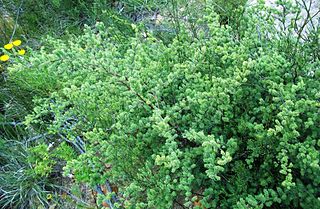
Penstemon, the beardtongues, is a large genus of roughly 280 species of flowering plants native to North America from northern Canada to Central America. It is the largest genus of flowering plants endemic to North America. As well as being the scientific name, penstemon is also widely used as a common name for all Penstemon species alongside beardtongues.

The Garibaldi, known historically also as the Catalina goldfish and marine goldfish and now commonly as the Garibaldi damselfish is a species of bright orange fish in the damselfish family. It occurs in the subtropical northeastern part of the Pacific Ocean. The Garibaldi is the official marine state fish of California, as of 1955, and has since been protected in California coastal waters from recreation and commercial fishing.

Halictidae is the second-largest family of bees with nearly 4,500 species. They are commonly called sweat bees, as they are often attracted to perspiration. Halictid species are an extremely diverse group that can vary greatly in appearance. These bees occur all over the world and are found on every continent except Antarctica. Usually dark-colored and often metallic, halictids are found in various sizes, colors and patterns. Several species are all or partly green and a few are red, purple, or blue. A number of them have yellow markings, especially the males, which commonly have yellow faces, a pattern widespread among the various families of bees. The family is one of many with short tongues and is best distinguished by the arcuate basal vein found on the wing. Females in this family tend to be larger than the males. They are the group for which the term 'eusocial' was first coined by entomologist, Suzanne Batra.

Uakari is the common name for the New World monkeys of the genus Cacajao. Both the English and scientific names are believed to have originated from indigenous languages.

Halictus rubicundus, the orange-legged furrow bee, is a species of sweat bee found throughout the Northern Hemisphere. H. rubicundus entered North America from the Old World during one of two main invasions of Halictus subgenera. These invasions likely occurred via the Bering land bridge at times of low sea level during the Pleistocene epoch.
Pristimantis rubicundus is a species of frog in the family Strabomantidae. It is endemic to Ecuador. Its natural habitat is tropical moist montane forest. It is threatened by habitat loss.
Attenborougharion rubicundus is a species of air-breathing semi-slug, terrestrial pulmonate gastropod molluscs in the family Helicarionidae.

Phallus rubicundus is a species of fungus in the stinkhorn family. First described in 1811, it has a wide distribution in tropical regions. It has the typical stinkhorn structure consisting of a spongy stalk up to 15 cm (5.9 in) tall arising from a gelatinous "egg" up to 3 cm (1.2 in) in diameter. Atop the stalk is a pitted, conical cap that has a foul-smelling, gelatinous, green spore mass spread over it.

Zygaena rubicundus, common name fulvous burnet,. is a species of moth in the family Zygaenidae.

Asparagus rubicundus is a fluffy, thorny shrub of the Asparagus genus, that is endemic to the Cape Provinces of South Africa.
Rubicundus is a genus of hagfishes, the only extant member of the subfamily Rubicundinae. All species in it were formerly classified in Eptatretus. R. eos, R. lakeside, and R. rubicundus are known from single specimens caught in the Tasman Sea, Galápagos, and Taiwan, respectively. They are named after the distinctive red coloration that all species share.

Agnocoris is a genus of plant bugs in the family Miridae. There are about seven described species in Agnocoris.
Autumnimiris rubicundus is a species of plant bug in the family Miridae. It is found in Central America and North America.

Ellescus is a genus of true weevils in the beetle family Curculionidae. There are about 16 described species in Ellescus.
Paracosmus is a genus of bee flies in the family Bombyliidae. There are about five described species in Paracosmus.
Agnocoris rubicundus is a species of plant bug in the family Miridae. It is found in Europe and Northern Asia and North America.
Dicropaltum is a genus of robber flies in the family Asilidae. There are about six described species in Dicropaltum.
Paracosmus rubicundus is a species of bee flies in the family Bombyliidae.
Rubicundus eos, also known as the pink hagfish, is a species of jawless fish in the family Myxinidae.
Rubicundus lakeside, the Lakeside hagfish, is a species of jawless fish in the family Myxinidae.










